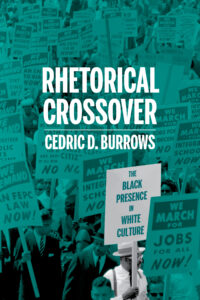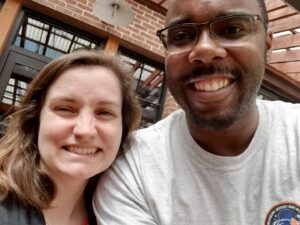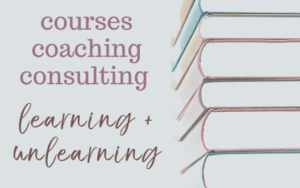This Q&A blog post features Cedric D. Burrows, Ph.D., an assistant professor of English at Marquette University and author of the new book, Rhetorical Crossover: The Black Presence in White Culture (University of Pittsburgh Press, 2020). Cedric’s scholarship focuses on African American rhetoric, cultural rhetorics, social activism, and the legacies and contributions of Dr. Martin Luther King, Jr., Malcolm X, and the Civil Rights Movement.
As a colleague of Cedric’s, I can tell you that not only is his research essential and his writing accessible, but his teaching is transformative. His courses on the African-American Rhetorical Tradition, Black Freedom Movement, and Memoirs of the Civil Rights Movement are much sought-after. And, lucky for us, Cedric shares his teaching publicly, as he’s regularly invited to speak at events; to talk with news media about how common words and phrases carry racist history; and most recently, to share what his book teaches about the Black presence in white culture.
In this blog post, you can learn more about Cedric’s book, but let me say before moving on, that Cedric lives out the role of educator: approaching life with curiosity and humor and translating scholarship into everyday conversations, meaningful interactions, and even social media posts. If you haven’t already, buy his book, and follow him online!
Why Read Rhetorical Crossover?
In Rhetorical Crossover, Cedric describes how features of whiteness put the onus on Black communicators to navigate minefields of whitescripting, whitescaping, and whitesplaining—exertions of power through expectations for Black communicators to be nonthreatening and to water down their rhetorical presence. Black communicators, then, must pay a “Black tax” when entering white spaces, which requires incredible toil and takes an incredible toll.
Of the articles and books I’ve read in the past year, Cedric’s is one I continue thinking about and reaching for to explain how whiteness works and how whiteness constructs and constrains possibilities. After reading Rhetorical Crossover, it’s clear that nothing—not communication, not education, not entertainment, not ourselves—are separate from race and racism. And it’s clear that white people have enormous responsibilities to learn and unlearn and change our relational and communicative patterns.
Truly, I can’t say enough: spend time with Cedric’s Rhetorical Crossover. It’s too important to pass over, and I hope this interview explains why.
Interview with Cedric D. Burrows, Ph.D.
1. What inspired you to write you the book?
Living in the Midwest was my biggest inspiration. I’m from Memphis, Tennessee, and went to graduate school in the Midwest, which was a big difference culturally, mainly because the areas in the Midwest where I lived (Oxford, Ohio and Lawrence, Kansas) had very small Black populations compared to Memphis, where the Black population was well over 60%.
In the Midwest, I encountered people whose only exposure to Black people and Black culture was through the media, which often led to a lot of misinterpretations or awkward encounters. For instance, I would often see a car full of white people who would blast rap music and would be rapping along to all of the lyrics, even saying the N-word in its entirety. Another case was when I would be in a place like the union building on campus or in a waiting room and a show like Meet the Browns or Love and Hip Hip would come on tv, and I’m the only Black person in the place, while everyone is watching these programs laughing at Meet the Browns or commenting on how “ghetto” Love and Hip Hop is.
If I was in those spaces with Black people, the shared background affects the way we watch the programs, but when being the only Black person in those spaces, I felt uncomfortable. That uncomfortable feeling led me to research how Blacks create a culture that reflects their/our needs and what happens when that culture crosses over into spaces where a group does not understand all of the cultural nuances Black people created.
Cedric recently gave this interview for PBS’s Black Nouveau series and further explains what motivates the book and what he hopes readers take away:
2. You weave personal stories throughout the book, helping us see the rhetorical concepts you’re developing. For example, in the first chapter, “Too Black, Too Strong: The Black Rhetorical Presence,” you share rules of racial etiquette needed to survive within white spaces. Could you share some of these rules, an excerpt of the book?
In the introduction, I share the pedagogical rules I learned after an encounter with a white woman student, who felt that I embarrassed her after I called her out on disturbing the class with side conversations. I recalled the events to a fellow instructor, who then told my teaching mentor. The teaching mentor felt that I needed to change her grade so it wouldn’t feel like I was picking on her. The following excerpt is my reflection on the experience:
“I now realized that my teaching advisor was giving me a pedagogical version of The Talk, and the pedagogical rules of The Talk were tailored for an African American professor at a predominantly white university. This cultural literacy involved the following:
- Always keep the door open and place the student’s chair close to the door. The student then has easy access to the door to prevent any accusations of assault, especially if the student is a white woman.
- Conference with confrontational students in a place where there are lots of people around or have someone else in your office to witness the events.
- Balance materials written by people of color with white authors to prevent notions of racial bias, especially when the subject matter is about race.
- Avoid challenging white students when they express racist ideas because it may interfere with your teaching evaluations, which would affect your merit pay.
- Smile often to appear nonthreatening to your students.
With these rules, I learned that even though I was the teacher, the voice of white students would have more weight than mine in a dispute. Also, while I had to learn both African American and white culture, the institution confirmed that white students did not have to learn anything about my culture. Finally, I was supposed to be seen as not “too serious” but as someone who could nurture and at times entertain students.” — Rhetorical Crossover, page 11

Book cover of Rhetorical Crossover: The Black Presence in White Culture by Cedric D. Burrows. Background photo by Marion S. Trikosko shows demonstrators holding signs during the March on Washington, 1963.
3. What do you want readers to know about Rhetorical Crossover? I think of it as part of your life’s work—as an author, a researcher, and an educator. What does this book mean to you, or where is this project leading you next?
I want readers to understand how we arrived at this moment in US history. In the late 1960s, the Kerner Commission stated that the US was becoming “two societies—separate and unequal.” One of the ways this inequality has and continues to manifest is in the way cultural groups communicate with each other. One group creates their rhetorical style, in part, as a response to the inequities they experience in society, while another group misinterprets this discourse and tries to reinterpret it to fit into their own standards, which furthers the miscommunication between the two groups.
Thus, I want people to read Rhetorical Crossover and understand how we are all “walking texts”—that is, our communication style is a result of our cultural and historical communities. Once we realize this, we can learn more about each other’s cultures and work to develop better communication between and across groups, which can ultimately create a more just and equal society. And it is this idea that has led to me to research how we memorialize and narrative the civil rights movement with spaces like statues and museums—the subject of my next research project.
4. Rhetorical Crossover makes many significant contributions, teaching about power and its communicative consequences, weaving historical and contemporary examples, looking across forms of discourse and media. I hope white readers see the need to reckon with and take accountability for the many structural, cultural, and interpersonal harms associated with whiteness (and white culture and white supremacy) that cumulate day after day. Do you have other lessons you hope readers take away for “everyday living for justice”?
I think the major takeaway is to show the various manifestations of racism in everyday life.
Oftentimes, some whites believe that racism is when someone says racist words but fail to recognize how racism can be embedded in various ways, most notably in our language practices. In learning about how racism is embedded in our communication practices, readers can take the opportunity to look within themselves and to see how they may unintentionally practice racist behaviors.
Case in point: I receive messages from people who ask me “how to be an ally so I can help others.” I respond that while they are earnest in their intent, focusing on being an “ally” to help others can reinforce what you’re trying to tear down because the focus becomes more on trying to save someone rather than seeing the person and practicing empathy. In the process, the “ally” sees the person that they are trying to help as a “thing” instead of seeing a person. Thus, I want people to think about what they say, how they say it, and what effects those words and other communication practices have on various people, various communities.

I’m deeply grateful for Cedric Burrows for years of learning, teaching, reading, and writing together. May I continue to learn from your research and many books to come. ~ Beth
—
This interview is conducted by Beth Godbee, Ph.D. with Cedric Burrows, Ph.D. for Heart-Head-Hands.com. Other recent interviews include Tamika Carey, Ph.D.; Rasha Diab, Ph.D.; and Ileana Rodriguez.
You can buy a copy of Rhetorical Crossover: The Black Presence in White Culture from University of Pittsburgh Press, online book sellers, or your local bookstore.
To support the work of Heart-Head-Hands: Everyday Living for Justice, become a subscriber via Patreon. And consider subscribing to the newsletter for additional resources and announcements. Thanks!




I really enjoyed the interview b/w Beth and Cedric as well as the PBS interview. I truly hope this work makes its way to many minds and hearts.
Such an important work. Thanks for the resource.